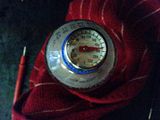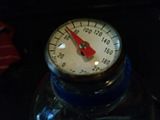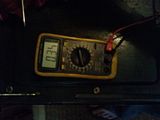Testing OE IAT sensor compared to fast reacting IAT sensor
#1
Testing OE IAT sensor compared to fast reacting IAT sensor
Is anyone willing to lend me one for a while?
I got a fast reacting sensor and want to make back-to-back comparison of their impedance v. temp
Too cold now to take my UIM out...
I will then post the results.
Thanks
- Sandro
I got a fast reacting sensor and want to make back-to-back comparison of their impedance v. temp
Too cold now to take my UIM out...
I will then post the results.
Thanks
- Sandro
Last edited by gracer7-rx7; 03-22-10 at 10:09 AM. Reason: better title
#3
You know Mazda actually changed their design right? I have a new one and I've compared it to the old ones from 93ish and they are different. I'm sure the impedence is about the same though.
the main thing that's different is the actual element... it's just a solid piece of metal with plastic around it.
the main thing that's different is the actual element... it's just a solid piece of metal with plastic around it.
#5
You know Mazda actually changed their design right? I have a new one and I've compared it to the old ones from 93ish and they are different. I'm sure the impedence is about the same though.
the main thing that's different is the actual element... it's just a solid piece of metal with plastic around it.
the main thing that's different is the actual element... it's just a solid piece of metal with plastic around it.
I made some preliminary readings of the fast sensor and wanted to see if there are any appreciable differences. The new sensor is highly non-linear at higher temperatures. This is how it looks like...
T-F T-C T- K Ohm
32 0 273.15 5.52
69 20.6 293.7 2.15
115 46.1 319.3 0.98
185 85.0 358.2 0.32
250 121.1 394.3 0.18
T-F = temperature in F deg
T-C = temp in Centigrades
T-K = temp in Kelvin (you need that to make correlations for a thermistor)
I guess this is typical of a thermistor.
http://www.omega.com/temperature/Z/pdf/z036-040.pdf
Has anyone made comparisons already?
#7
No, I didn't know that. Mine is '93
I made some preliminary readings of the fast sensor and wanted to see if there are any appreciable differences. The new sensor is highly non-linear at higher temperatures. This is how it looks like...
T-F T-C T- K Ohm
32 0 273.15 5.52
69 20.6 293.7 2.15
115 46.1 319.3 0.98
185 85.0 358.2 0.32
250 121.1 394.3 0.18
T-F = temperature in F deg
T-C = temp in Centigrades
T-K = temp in Kelvin (you need that to make correlations for a thermistor)
I guess this is typical of a thermistor.
http://www.omega.com/temperature/Z/pdf/z036-040.pdf
Has anyone made comparisons already?
I made some preliminary readings of the fast sensor and wanted to see if there are any appreciable differences. The new sensor is highly non-linear at higher temperatures. This is how it looks like...
T-F T-C T- K Ohm
32 0 273.15 5.52
69 20.6 293.7 2.15
115 46.1 319.3 0.98
185 85.0 358.2 0.32
250 121.1 394.3 0.18
T-F = temperature in F deg
T-C = temp in Centigrades
T-K = temp in Kelvin (you need that to make correlations for a thermistor)
I guess this is typical of a thermistor.
http://www.omega.com/temperature/Z/pdf/z036-040.pdf
Has anyone made comparisons already?
FSM STOCK SENSOR RESISTANCE................................. FAST REACTING SENSOR
@68 *F (20c) 2.20 - 2.70 Ohms..................................Tested @68 *F (20c) = 2.27 Ohms
@176*F (80c) 0.29 - 0.35 Ohms.................................Tested @176*F (80c) = 0.34 Ohms
As you can see it's at least in line with the stock FSM resistance from 20-80*C, and I'm sure its quite close above and below that as well.




Trending Topics
#8
I did a little of research to learn more about the thermistors T-ohm relation
Omega has good information on their website
http://www.omega.com/temperature/Z/pdf/z036-040.pdf
I tried to calculate the three coefficients A, B, and C of the Steinhart-Hart
equation, to see if I could find good fits with the empirical data I measured
1/T = A + BlnR + C (In R)3
T is in Kelvin degrees and R in Ohm
I used three measurements (69, 115, and 185 F) to solve the equations and came out with
A=3.131E-03
B=3.80E-04
C=-5.7E-05
After plugging these in the formula I found good agreement (+/- 1F) with the three measurements I used to derive the coefficients, but quite a difference at the extreme (+13F at 32F and -33F at 250F)
Using Excel, I then tried to fit the measurements the best I could, with small changes of the coefficients. The set below works pretty well.
A=3.131E-03
B=3.60E-04
C=-1.5E-05
I need to add, I used a precision Fluke multimeter to measure impedance but the temperature measurements were approximate as I used an inexpensive non-contact infrared thermometer and warm air from a hair dryer.
Anyhow, notice how impedance values get so small at higher temperature with this sensors. Minuscule changes in impedance generate quite large difference in temperature reading. I am wondering if this intrinsic inaccuracy should be taken somehow into account in the PFC settings that are [high] temperature dependent.
- Sandro
Omega has good information on their website
http://www.omega.com/temperature/Z/pdf/z036-040.pdf
I tried to calculate the three coefficients A, B, and C of the Steinhart-Hart
equation, to see if I could find good fits with the empirical data I measured
1/T = A + BlnR + C (In R)3
T is in Kelvin degrees and R in Ohm
I used three measurements (69, 115, and 185 F) to solve the equations and came out with
A=3.131E-03
B=3.80E-04
C=-5.7E-05
After plugging these in the formula I found good agreement (+/- 1F) with the three measurements I used to derive the coefficients, but quite a difference at the extreme (+13F at 32F and -33F at 250F)
Using Excel, I then tried to fit the measurements the best I could, with small changes of the coefficients. The set below works pretty well.
A=3.131E-03
B=3.60E-04
C=-1.5E-05
I need to add, I used a precision Fluke multimeter to measure impedance but the temperature measurements were approximate as I used an inexpensive non-contact infrared thermometer and warm air from a hair dryer.
Anyhow, notice how impedance values get so small at higher temperature with this sensors. Minuscule changes in impedance generate quite large difference in temperature reading. I am wondering if this intrinsic inaccuracy should be taken somehow into account in the PFC settings that are [high] temperature dependent.
- Sandro
#9
I couldn't say for sure. if the differences matter, but in the FSM they have a certain amount of fluctuations allowed. 2.20 - 2.70 Ohms at 20c and 0.29 - 0.35 Ohms at 80c, given both sensors have the same curve I imagine the small changes in impedance would effect the stock sensor in the same way.
As far as the PFC is concerned, I don't think the stock sensor ever really reads the correct temperature, and so whatever stock values are entered into the air correction table won't do much for a sensor thats not even close to the right temp. Now, as far as the new sensor is concerned, for the most precise tune from winter to summer it's best to tune them as the weather changes. This is what I did, and now my AFR's are very close to dead on between air temp changes. In the end consistent AFR's is the ideal goal. But I've also had many people leave the tables alone, even using the sensor with the stock computer and the car runs better just from the sensor change. There is usually a safety net in the fuel corrections for the stock sensor, so it definitely won't be any worse by changing to a faster sensor.
As far as the PFC is concerned, I don't think the stock sensor ever really reads the correct temperature, and so whatever stock values are entered into the air correction table won't do much for a sensor thats not even close to the right temp. Now, as far as the new sensor is concerned, for the most precise tune from winter to summer it's best to tune them as the weather changes. This is what I did, and now my AFR's are very close to dead on between air temp changes. In the end consistent AFR's is the ideal goal. But I've also had many people leave the tables alone, even using the sensor with the stock computer and the car runs better just from the sensor change. There is usually a safety net in the fuel corrections for the stock sensor, so it definitely won't be any worse by changing to a faster sensor.
#10
All good considerations.
I was wondering at first whether the stock sensor could perhaps obey to a different T-Ohm curve, like linear rather than exponential. But probably it doesn't and the curves must be similar.
If the stock sensor curve were linear - by extrapolating the two values of the FSM one would conclude it would stop reading at 90 C, which we know it's not the case.
Thanks.
- Sandro
I was wondering at first whether the stock sensor could perhaps obey to a different T-Ohm curve, like linear rather than exponential. But probably it doesn't and the curves must be similar.
If the stock sensor curve were linear - by extrapolating the two values of the FSM one would conclude it would stop reading at 90 C, which we know it's not the case.
Thanks.
- Sandro
#13
Sensors compared
Made comparison and took voltage measurements in the range 30-80 deg C. Results were excellent.
The V-ohm curves of the two sensors are very consistent, both have the same shape. Difference was systematically 1.5 C
Below is the list of all measurements taken.
Temp - C ----- V stock ----- V fast
88.2 ---------- 0.26
85.4 ---------- ---------- ---------- 0.28
84.1 ---------- 0.28
83.1 ---------- 0.29
82.6 ---------- ---------- ---------- 0.30
81.1 ---------- ---------- ---------- 0.31
80.6 ---------- 0.31
80.0 ---------- 0.32
78.9 ---------- ---------- ---------- 0.33
78.0 ---------- ---------- ---------- 0.34
77.4 ---------- 0.34
77.2 ---------- 0.35
76.6 ---------- ---------- ---------- 0.35
76.1 ---------- ---------- ---------- 0.36
75.0 ---------- 0.37
74.0 ---------- 0.38
73.8 ---------- ---------- ---------- 0.38
73.2 ---------- ---------- ---------- 0.39
72.5 ---------- 0.40
72.0 ---------- 0.41
71.5 ---------- ---------- ---------- 0.40
71.0 ---------- ---------- ---------- 0.41
70.3 ---------- 0.43
69.6 ---------- ---------- ---------- 0.43
69.0 ---------- ---------- ---------- 0.44
68.6 ---------- 0.45
68.0 ---------- 0.46
67.5 ---------- ---------- ---------- 0.46
67.0 ---------- ---------- ---------- 0.47
66.2 ---------- 0.48
65.5 ---------- 0.49
65.0 ---------- ---------- ---------- 0.49
64.5 ---------- ---------- ---------- 0.50
63.5 ---------- 0.52
63.0 ---------- ---------- ---------- 0.52
62.5 ---------- ---------- ---------- 0.53
62.0 ---------- 0.55
61.5 ---------- ---------- ---------- 0.55
61.0 ---------- 0.57
60.5 ---------- 0.58
60.0 ---------- ---------- ---------- 0.57
59.5 ---------- 0.60
69.0 ---------- ---------- ---------- 0.59
58.5 ---------- 0.62
58.0 ---------- ---------- ---------- 0.60
57.5 ---------- 0.64
57.0 ---------- ---------- ---------- 0.63
56.5 ---------- 0.65
56.0 ---------- ---------- ---------- 0.64
55.5 ---------- 0.67
55.0 ---------- ---------- ---------- 0.66
54.5 ---------- 0.70
54.0 ---------- ---------- ---------- 0.69
53.5 ---------- 0.72
53.0 ---------- ---------- ---------- 0.71
52.5 ---------- 0.75
52.0 ---------- ---------- ---------- 0.74
51.5 ---------- 0.77
51.0 ---------- ---------- ---------- 0.76
50.5 ---------- 0.80
50.0 ---------- ---------- ---------- 0.79
49.5 ---------- 0.83
49.0 ---------- ---------- ---------- 0.82
48.5 ---------- 0.86
48.0 ---------- ---------- ---------- 0.84
47.5 ---------- 0.90
47.0 ---------- ---------- ---------- 0.87
46.5 ---------- 0.93
46.0 ---------- ---------- ---------- 0.90
45.5 ---------- 0.96
45.0 ---------- ---------- ---------- 0.93
44.5 ---------- 0.99
44.0 ---------- ---------- ---------- 0.96
43.5 ---------- 1.03
43.0 ---------- ---------- ---------- 1.00
42.5 ---------- 1.07
42.0 ---------- ---------- ---------- 1.04
41.5 ---------- 1.11
41.0 ---------- ---------- ---------- 1.09
40.5 ---------- 1.16
40.0 ---------- ---------- ---------- 1.13
39.5 ---------- 1.20
39.0 ---------- ---------- ---------- 1.16
38.5 ---------- 1.24
38.0 ---------- ---------- ---------- 1.21
37.5 ---------- 1.30
37.0 ---------- ---------- ---------- 1.25
36.5 ---------- 1.35
36.0 ---------- ---------- ---------- 1.30
35.5 ---------- 1.40
35.0 ---------- ---------- ---------- 1.35
34.5 ---------- 1.46
34.0 ---------- ---------- ---------- 1.40
33.5 ---------- 1.52
33.0 ---------- ---------- ---------- 1.46
32.5 ---------- 1.59
32.0 ---------- ---------- ---------- 1.52
31.5 ---------- 1.65
31.0 ---------- ---------- ---------- 1.58
30.5 ---------- 1.71
30.0 ---------- ---------- ---------- 1.64
I also measured response time from ambient temperature to around 40 C.
Compared with the static table and stopped the clock at 90% of static voltage (actually 110% because voltage decrease as temp increases). Fast acting sensor response time was below 15 sec; OE sensor response time was above 30 sec.
- Sandro
The V-ohm curves of the two sensors are very consistent, both have the same shape. Difference was systematically 1.5 C
Below is the list of all measurements taken.
Temp - C ----- V stock ----- V fast
88.2 ---------- 0.26
85.4 ---------- ---------- ---------- 0.28
84.1 ---------- 0.28
83.1 ---------- 0.29
82.6 ---------- ---------- ---------- 0.30
81.1 ---------- ---------- ---------- 0.31
80.6 ---------- 0.31
80.0 ---------- 0.32
78.9 ---------- ---------- ---------- 0.33
78.0 ---------- ---------- ---------- 0.34
77.4 ---------- 0.34
77.2 ---------- 0.35
76.6 ---------- ---------- ---------- 0.35
76.1 ---------- ---------- ---------- 0.36
75.0 ---------- 0.37
74.0 ---------- 0.38
73.8 ---------- ---------- ---------- 0.38
73.2 ---------- ---------- ---------- 0.39
72.5 ---------- 0.40
72.0 ---------- 0.41
71.5 ---------- ---------- ---------- 0.40
71.0 ---------- ---------- ---------- 0.41
70.3 ---------- 0.43
69.6 ---------- ---------- ---------- 0.43
69.0 ---------- ---------- ---------- 0.44
68.6 ---------- 0.45
68.0 ---------- 0.46
67.5 ---------- ---------- ---------- 0.46
67.0 ---------- ---------- ---------- 0.47
66.2 ---------- 0.48
65.5 ---------- 0.49
65.0 ---------- ---------- ---------- 0.49
64.5 ---------- ---------- ---------- 0.50
63.5 ---------- 0.52
63.0 ---------- ---------- ---------- 0.52
62.5 ---------- ---------- ---------- 0.53
62.0 ---------- 0.55
61.5 ---------- ---------- ---------- 0.55
61.0 ---------- 0.57
60.5 ---------- 0.58
60.0 ---------- ---------- ---------- 0.57
59.5 ---------- 0.60
69.0 ---------- ---------- ---------- 0.59
58.5 ---------- 0.62
58.0 ---------- ---------- ---------- 0.60
57.5 ---------- 0.64
57.0 ---------- ---------- ---------- 0.63
56.5 ---------- 0.65
56.0 ---------- ---------- ---------- 0.64
55.5 ---------- 0.67
55.0 ---------- ---------- ---------- 0.66
54.5 ---------- 0.70
54.0 ---------- ---------- ---------- 0.69
53.5 ---------- 0.72
53.0 ---------- ---------- ---------- 0.71
52.5 ---------- 0.75
52.0 ---------- ---------- ---------- 0.74
51.5 ---------- 0.77
51.0 ---------- ---------- ---------- 0.76
50.5 ---------- 0.80
50.0 ---------- ---------- ---------- 0.79
49.5 ---------- 0.83
49.0 ---------- ---------- ---------- 0.82
48.5 ---------- 0.86
48.0 ---------- ---------- ---------- 0.84
47.5 ---------- 0.90
47.0 ---------- ---------- ---------- 0.87
46.5 ---------- 0.93
46.0 ---------- ---------- ---------- 0.90
45.5 ---------- 0.96
45.0 ---------- ---------- ---------- 0.93
44.5 ---------- 0.99
44.0 ---------- ---------- ---------- 0.96
43.5 ---------- 1.03
43.0 ---------- ---------- ---------- 1.00
42.5 ---------- 1.07
42.0 ---------- ---------- ---------- 1.04
41.5 ---------- 1.11
41.0 ---------- ---------- ---------- 1.09
40.5 ---------- 1.16
40.0 ---------- ---------- ---------- 1.13
39.5 ---------- 1.20
39.0 ---------- ---------- ---------- 1.16
38.5 ---------- 1.24
38.0 ---------- ---------- ---------- 1.21
37.5 ---------- 1.30
37.0 ---------- ---------- ---------- 1.25
36.5 ---------- 1.35
36.0 ---------- ---------- ---------- 1.30
35.5 ---------- 1.40
35.0 ---------- ---------- ---------- 1.35
34.5 ---------- 1.46
34.0 ---------- ---------- ---------- 1.40
33.5 ---------- 1.52
33.0 ---------- ---------- ---------- 1.46
32.5 ---------- 1.59
32.0 ---------- ---------- ---------- 1.52
31.5 ---------- 1.65
31.0 ---------- ---------- ---------- 1.58
30.5 ---------- 1.71
30.0 ---------- ---------- ---------- 1.64
I also measured response time from ambient temperature to around 40 C.
Compared with the static table and stopped the clock at 90% of static voltage (actually 110% because voltage decrease as temp increases). Fast acting sensor response time was below 15 sec; OE sensor response time was above 30 sec.
- Sandro
#14
Linking back to Dude's original thread on this fast reacting IAT sensor:
https://www.rx7club.com/power-fc-forum-47/any-air-temp-sensors-share-same-range-fd-842255/
Also placed this in the FAQ and changed thread title.
Thank you Sandro and Dude/Brent for doing the research on this sensor. I have it and it works so much better than stock.
https://www.rx7club.com/power-fc-forum-47/any-air-temp-sensors-share-same-range-fd-842255/
Also placed this in the FAQ and changed thread title.
Thank you Sandro and Dude/Brent for doing the research on this sensor. I have it and it works so much better than stock.
Last edited by gracer7-rx7; 03-22-10 at 10:10 AM.
#17
as a side note, here's what I was saying about the newer style OEM air temp sensor:

if you sand that plastic off it will be bare solid metal and look a lot like the OEM water temp sensor:

Interestingly enough, Mazda actually used an exposed element IAT sensor on the 2nd gen cars:

This was located in the TB elbow right before the throttle plates. It was used mostly for ISC valve control logic, but the resistance curve is not the same as the FD's. There was another IAT sensor located in the airflow meter assembly of the 2nd gen cars.

if you sand that plastic off it will be bare solid metal and look a lot like the OEM water temp sensor:

Interestingly enough, Mazda actually used an exposed element IAT sensor on the 2nd gen cars:

This was located in the TB elbow right before the throttle plates. It was used mostly for ISC valve control logic, but the resistance curve is not the same as the FD's. There was another IAT sensor located in the airflow meter assembly of the 2nd gen cars.
Thread
Thread Starter
Forum
Replies
Last Post
Skeese
Adaptronic Engine Mgmt - AUS
65
03-28-17 03:30 PM
acting, ait, buy, comparison, comparisons, fast, fd3s, iat, mazda, oe, oem, rx7, sandroavatari, sensor, sitelancerregistercom, steinhart



